New perk! Get after it with local recommendations just for you. Discover nearby events, routes out your door, and hidden gems when you sign up for the Local Running Drop.
Quirks and all, Boulder is a trail runner’s paradise
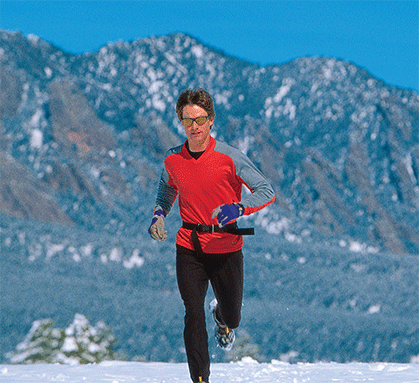
Running the Dowdy Draw Trail in springtime with the famous Boulder Flatirons in the background. Photo by David Clifford.
If you want to delve into the core of one of the greatest trail- running meccas on the planet, start by ordering a bagel. The coffee shop might be the sanctum of American society, but Moe’s Bagels, in north Boulder’s always-crowded Community Plaza shopping center, is the fueling station for endorphin-stoked Boulderites. On any given Saturday morning, you might find a group of trail runners gearing up for or returning from an all- day mountain run, Spandex-clad cyclists starting or finishing long road rides, and perhaps a multi-sport athlete or two taking a break between sessions.
“Hey, Mark, we missed you on the long run last week—where were you?” says an ultrarunner, Scott Boulbol, stuffing a bagel into his running pack.
“I was under the weather, so I only did two hours and it was slow. I needed to take it easy,” comes a voice from Mark Thatcher, who hurriedly makes his way to a car in the parking lot, getting louder as he goes. “But I’m running about four tomorrow if you want to go. I just signed up for the San Juan Solstice 50-miler and need to get some miles in.”
“Sure, but we have to be back in time so I can get in a couple hours on my bike, too,” comes Scott’s reply. “Kurt and I are going to ride some hills if you want to join us.”
“Cool, call me,” Mark says with a wave. “I gotta go, we’re going to do that 50K in Littleton and my ride is leaving.”
The free-spirited town of Boulder is a unique melting pot of conventional and alternative. It’s a cross between high-tech Palo Alto and philosophizing Katmandu, seasoned with a bit of free-spirited American Western audacity and holdover hippie glee. Home to the University of Colorado and the Buddhist-slanted Naropa University, Boulder boasts a population of 102,000 that’s hard-working, highly educated and even more opinionated. It also has strong cultural roots in music, writing and progressive thinking, a bevy of federal research laboratories, and a host of entrepreneurial start-ups that have gone national. But it’s how you play, not what you do for work, that really defines who you are in this town.
“People don’t come here for the great art galleries or museums,” says a trail-running legend, Buzz Burrell, who’s been running Boulder’s trails since 1968. “People come here to go outside and play. The real reason people move here is to be with other athletes, to be part of the community synergy.”
Surrounded by countless acres of publicly owned open space and rolling mountain parks, the city offers everything a trail runner could possibly want. Nestled in the foothills of the Rockies 30 miles north- west of Denver, it has a mild climate with more sunny days than San Diego and a seemingly unlimited amount of dirt trails—from the rolling trails and steep paths that start near Chautauqua Park under the Flatirons to the soft, smooth and mostly flat routes that surround the city on the north, east and south, as well as the nearby Indian Peaks Wilderness Area, with its dozens of spectacular high-altitude sojourns.
Frank Shorter, marathon legend and longtime Boulder resident, offered an egalitarian overview to the Boulder Daily Camera last year: “Nothing dom- inates the culture here, not the university, not Naropa, not the touchy-feelies, not the screaming conservatives, and not the athletes.”
Shorter was one of the first to draw attention to the town when he won the 1972 Olympic marathon while training part-time in Boulder. His victory and subsequent silver medal in 1976 were the primary catalysts of the first national running boom, and Boulder, where he has lived full-time since 1975, has been ground-zero for endurance sports ever since.
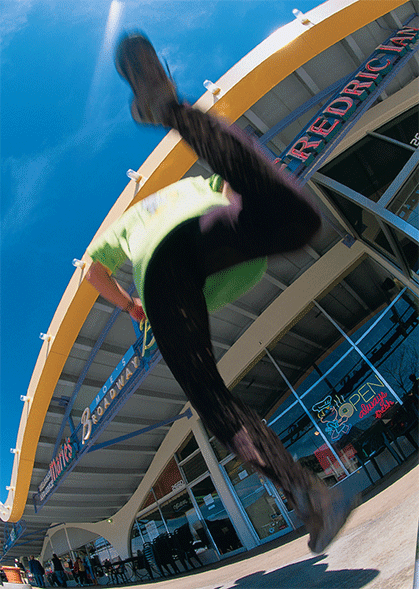
Sprinting to Moe’s to fuel up. Photo by David Clifford.
“I came here on vacation and fell in love with this place,” says Mark Plaatjes, winner of the 1993 World Championships marathon and co-owner of the Boulder Running Company retail store. “The natural beauty of the place attracted me, combined with the great trails and the great support system—there are a lot of medical facilities and doctors and resources here. Everybody caters to the athletes.”
Dozens of other world-class track and road runners, including Rob de Castella (1983 World Champi- onships marathon winner), Lorraine Moller (1992 Olympic marathon bronze medallist), Uta Pippig (three-time Boston Marathon champion) and Arturo Barrios (former world record holder, 10,000-meter run), followed Shorter’s lead in the last three decades, as did numerous triathletes, cyclists and adventure racers. Some have stayed, some have moved on. But with the University of Colorado’s men’s and women’s cross-country teams perennially among the nation’s best and a horde of trail-running whackos around, the bar is always set pretty high, even for recreational athletes.
It’s not uncommon for an Olympic runner, Ironman triathlon champion or Leadville 100 winner—several from each category call Boulder home—to zip by you on the trails on your morning run. “It happens quite a bit,” Boulbol says, “but not everyone knows who just ran by them.” Nor is it out of the ordinary to be sitting at a restaurant and overhear someone talking about some wild endurance adventure, regardless of the sport. All this talent creates a trickle-down inspiration, a quiet verve that compels athletes of all ability levels to train harder than they might if they lived elsewhere.
“It’s great to be able to go for a run anywhere, at any time, and of haughty eccentrics. not be looked at with surprise,” says a longtime Boulder resident, Scott Elliott, a seven-time winner of the Pikes Peak Ascent in Manitou Springs, Colorado. “It’s more normal in Boulder to be fit, look fit, act fit than anywhere else I’ve ever been. I never have to think twice about walking into a store, business or restaurant dressed in running clothes and with my legs covered in mud.”
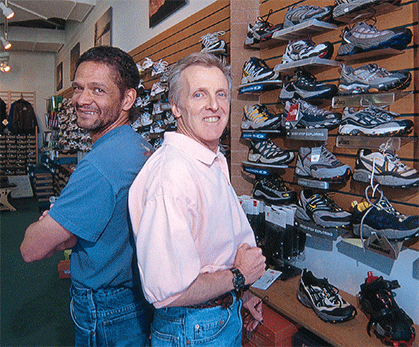
Boulder Running Company co-owners and accomplished runners, Mark Plaatjes and Johnny Halberstadt, at the office. Photo by David Clifford.
Elliott’s legs are often covered in mud, even when he goes to work (with his dog, Remmy) as a contract computer software technician. With his legendary local run ning feats, Elliott is among those who quietly raise standards. He’s recorded many of the fastest times up the craggy south ridge of Mount Sanitas and in 2001 ran the six-mile round trip up and down Boulder’s Green Mountain 120 consecutive days—every one of them at a hammering pace.
Bill Wright, on the other hand, is a self-proclaimed “average Joe,” fast but not an elite runner. He’s become a guru of early-morning time trials on Boulder trails, organizing one a week throughout the summer and fall. As many as two dozen people show up for what is usually a race-pace workout up one of the area’s steepest trails.
“The difference in Boulder isn’t just the quantity of outdoor athletes, which is huge, but the quality is outrageous,” Wright says. “I’ve learned to just assume that anyone I meet can outrun me, out-bike me, and out-climb me and maybe by huge margins. My favorite expression is: ‘Move to Boulder and be humble!’”
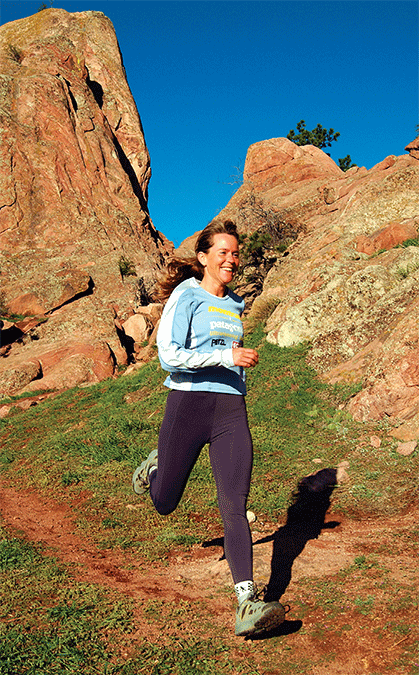
Uber ultrarunner Stephanie Ehret starts her day at the convenient Red Rocks area. Photo by David Clifford.
Not everyone thinks Boulder is such a cool place. In fact, adventure, regardless of the sport. All this talent creates a trickle-down much of the rest of the Front Range population sardonically refers to the town as the “People’s Republic of Boulder,” both for its liberal politics and what they think is a population of haughty eccentrics.
Outsiders think Boulder oozes snobbery, that its uber-fit, ultra-competitive population looks down on slower runners, cyclists and triathletes from places outside of its glass dome.
“You Boulderites need to get out of your sheltered, insulated little community more often,” Adam Feerst says half-jokingly. Feerst, a competitive runner from Golden who organizes a Denver-area trail-running group, suggests the generalizations and labels aren’t completely off-base. “It is a little elitist,” he says. “To me, we’re all part of the same metropolitan area.”
Maybe, but Boulder clearly marches to a different drummer. While there are many other strong running communities in Colorado – notably Fort Collins, Colorado Springs and Vail – Boulder’s history and high per-capita running population give it a unique, trend-setting vibe. For that reason, the $5 billion outdoor sports industry has kept a keen focus on it for years. Salomon, Kelty, GoLite, Sierra Designs, La Sportiva, Hind, The North Face, Lowe Alpine and Pearl Izumi are among the many outdoor apparel and equipment companies that have had offices or headquarters in the area, while nationally distributed magazines covering skiing, running, climbing, triathlon, cycling and adventure racing have called Boulder home in recent years. Boulder also has one of the highest per-capita populations of both massage therapists (more than 150) and psychotherapists (nearly 300), not to mention Himalayan restaurants (seven), sushi bars (six) and organic food grocery stores (six).
Despite its status as a fitness hub, Boulder has plenty of quirks. While it’s illegal to smoke cigarettes inside most restaurants and bars (except in a separate, enclosed room), the city has an ongoing problem with smog caused, in part, from the above-average population of SUVs that roam Boulder’s streets. Go for a run outside the city limits and the brown cloud over Boulder can look like collective exhalation of the chain-smoking, patchouli-scented youth that hang out on the streets of University Hill.
Although Boulder is the home of the International Mountain Biking Association trail-advocacy group, city ordinances prohibit mountain bikes on the majority of its best singletrack trails. And despite it being one of the world’s great trail-running centers, similar regulations make it nearly impossible to hold a running race on any of the trails in the city’s mountain parks.
While virtually every other municipality and land agency along the Front Range has figured a way to allow both types of activities, convoluted land-management policies are a constant frustration in Boulder. Beginning in the late 1960s, the local governments proactively saved a lot of land from development and sprawl, but now that open space is protected with strict regulations.
That hasn’t stopped mountain bikers from seeking out epic bandit routes outside city limits, nor has it discouraged the Basic Boulder Mountain Marathon. An outlaw race that has been strictly prohibited by the authorities, the BBMM has nonetheless been held every year since Kevin Cooney and Neal Beidleman started it in 1984. The race, which varies from 22 to 27 miles depending on the course, has become a cult classic, attracting a diverse group of 50 to 250 athletes who learn of the starting location only days before the event via e-mail and hearsay.
“Never heard of it,” Burrell says, echoing the words of everyone connected with it. “I don’t know anything about it.”
The Bolder Bolder Boulder 20K is another unsanctioned event that has been known to take place concurrently as 45,000 people pound the pavement in the Bolder Boulder 10K road race on Memorial Day.
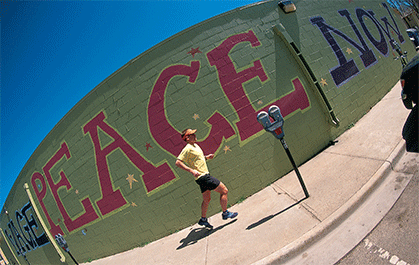
It’s hard to ignore this politically charged message in downtown Boulder. Photo by David Clifford.
In the mid-1990s, Boulder gained a bit of notoriety from a peculiar ultrarunning club called Divine Madness. Some called it a legitimate running group – and it did claim two Leadville 100 champions, Steve Peterson and Janet Runyan. Others, including the New York Times, referred to it as a cult. “We don’t carry guns,” then group member Jonathan Rogers protested to the Times in 1997. “We’re not Heaven’s Gate. We missed the comet.” The Community, as it was called by those involved, was led by a zealot named Marc Tizer, who was known simply as “Yo” (short for Yousef Amin) to those who bought into his grab-bag of spiritual doctrines.
When the group splintered amid lawsuits in the late 1990s, some of its members admitted that, in addition to ultra-distance running, communal living and sex-partner swapping were practiced. The group still exists, although it is much smaller than in its heyday, when it claimed about 100 members. Several former members have been in and out of therapy for the last half decade. Tizer has since moved to New Mexico, where the group occasionally holds running retreats.
“There’s such an illusion that I control people,” Tizer was quoted as saying in the 1997 article. “A cult is where everyone shaves their head and you have to give all your money over. This is something else, where people who are sincerely trying to improve themselves have a teacher who is more or less evolved and is trying to help them lead a more balanced, harmonious life. If these runners do as well in other parts of their lives, they can be exemplary people.”
The Community is now just history in Boulder. To see what the real trail-running scene is all about today, show up at Chautauqua Park at 5:30 any Thursday evening – rain, shine, snow or otherwise – to join the Boulder Trail Runners on the undulating trails in and around the Flatirons. The group was founded about five or six years ago as a means to kill time before Happy Hour at a local brew pub, and members have been known to put away a few cold ones after the workout.
Runners range from beginners to ultra-distance champions and come from all walks of life—rocket scientists, school teachers, contractors, lawyers, engineers and furniture craftsmen—all running the same route at the same moderate pace. The run leaders typically stop several times to make sure to regroup with any stragglers. That some of the group runs climb ungodly steep trails is consistent with the underlying notion in Boulder that you push your limits. Or, following the local adage, that which doesn’t make me stronger, kills me.
“What moves me is the group energy,” says Burrell. “There’s always somebody who wants to go with you, somebody who is faster or goes longer or trains harder. Whoever you are and whatever you want to do, there is someone to share it with.”
The Boulder Trail Runners communicate through an e-group, which, like everything in Boulder, can be convoluted with egos and agendas. But, for the most part, the email sounding board is where long weekend training runs are planned, rides to weekend races arranged, stories swapped, issues debated and race reports posted.
Boulder’s landscape and mountainous backdrop offer a sheer beauty that automatically provides inspiration to a trail runner. Of the 180 miles of close-in trails, some are steep mountain routes and others are flat fire roads. But virtually every Colorado running community has picturesque scenery, so that’s only part of the equation in Boulder.
“We’re extremely lucky to have the roads and trails and hills and flats and running community we have, all reachable right outside our doors, with no driving,” says trail runner and triathlete Scott Schumaker. “If I start taking this for granted, which is rare, all it takes is a three- or four-day trip to just about anywhere else to slap me back to full appreciation.”
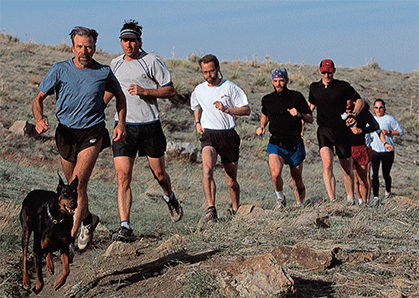
Adventure-running legend Buzz Burrell (no, not the dog) leads the Tuesday afternoon tempo run, this one on the Foothills Trail in North Boulder. He is followed by Dave Mackey, Paul Pomeroy, Jed DeOrsay, Steve McClung, Clarence Harrison (obscured), Justin Snow (obscured) and Julie Hudetz. Photo by David Clifford.
Boulder’s Boldest
Boulder’s endurance fiends include the 1972 Olympic marathon champ Frank Shorter, six-time Hawaii Ironman winner Dave Scott and three-time Eco-Challenge victor Ian Adamson — all of whom are trail runners. Here are a few more…
>Bob Africa, 30, footwear marketing guru for Salomon, champion trail runner and adventure racer. Africa won the San Juan Solstice 50-miler in 2001. He and Darcy Piceu (see below) make up one of the fastest trail-running couples in the nation.
>Peter Bakwin, 40, a climate-monitoring scientist for the National Oceanic & Atmospheric Administration in Boulder, elite ultra-runner and one of the leaders of the Boulder Trail Runners group. In March, Bakwin won a 252-mile, six-day stage race on the Tuscarora Trail between Pennsylvania and Virginia. He and Stephanie Ehret (see below) make up one of the fastest ultrarunning couples in the country.
>Buzz Burrell, 50, a Boulder-based contractor and adventure-running legend who owns records on the Colorado Trail and the John Muir Trail (with Bakwin). Burrell, who rarely enters a race, is kind of like the Obi-Wan Kenobi of local trail running.
>Alan Culpepper, 30, an Adidas-sponsored runner and 2000 U.S. Olympian in the 10,000-meter run.
>Colleen De Reuck, 39, a Nike-sponsored road-racing and cross-country running champion and three-time South African Olympian. De Reuck was the bronze medallist at the 2002 World Cross-Country Championships and helped the U.S. team finished third in that event in 2003.
>Stephanie Ehret, 40, a Montrail-sponsored runner and one of the nation’s top female ultra-runners. A massage therapist by trade, she placed second in France’s grueling 710- mile La Trause Gaule stage race in 2002 and was the third woman at the 2000 Western States 100.
>Scott Elliott, 39, a computer software guru and seven-time winner of Pikes Peak Ascent, the 13.3-mile run up the side of Pikes Peak in Manitou Springs, Colorado.
>Adam Goucher, 28, a Fila-sponsored runner and 2000 U.S. Olympian in the 5000-meter run and 1998 NCAA cross-country champion.
>Lisa Goldsmith, 38, a massage therapist and standout road, trail, mountain and snowshoe runner. She has won the 2001 North American Snowshoe Championships and numerous other trail, road and multi-sport races.
>Johnny Halberstadt, 53, co-founder of Boulder Running Company retail store (with Mark Plaatjes), 1972 NCAA 10,000-meter champion, sub-2:12 marathoner. Halberstadt is also a running-shoe guru with numerous patents to his credit.
>Dave Mackey, 33, a Nike ACG-sponsored runner, is one of the nation’s top trail runners from half-marathon to 50 miles. He was the runner-up at the USA 50K Trail Championships in 2002, and winner of Sunmart 50K and numerous mountain races last year.
>Steve Peterson, 42, a successful entrepreneur and the only five-time champ of the Leadville Trail 100, including 1996-1999 and 2001.
>Darcy Piceu, 28, graduate student, champion ultra-runner and multi-sport athlete. She was the top woman in the Leadville Trail Marathon and was the fifth woman in the Leadville 100 last year and set a new course record at the San Juan Trail 50K this spring.
>Mark Plaatjes, 42, the 1993 World Championships marathon winner. Plaatjes, a physical therapist who specializes in running injuries and the co-founder of the Boulder Running Company retail store, has won many trail races in recent years while training for the Comrades Marathon.
>Paul Pomeroy, 42, a La Sportiva-sponsored mountain runner, finishing carpenter and gonzo adventure runner. In 2002, Pomeroy set records on the 147-mile Kokopelli Trail and in April 2003 broke his own record on the White Rim Trail in Moab, Utah, running the 104-mile trail in just under 22 hours. He’s planning a 100-mile round-trip trail run from Boulder to the top of Longs Peak (14,255 feet) and back in July.
>Chad Ricklefs, 36, a graduate student and two-time winner of the Leadville Trail 100 (including last year’s record-breaking 17-hour 23-minute effort). Named 2002’s top ultrarunner by Ultrarunning and USATF, he won the 2002 USA 100K Championships on the roads.
>Janet Runyan, 43, an ultrarunning coach and the 2001 Leadville Trail 100 women’s champion and 1996 U.S. 100K road champion.
Boulder’s Best Trails
>Mesa Trail
Mesa Trail is a classic Western singletrack that meanders for 7 miles under Boulder’s tallest peaks from Chautauqua Park to the community of Eldorado Springs. Many singletrack offshoots here make a variety of runs possible, including up the tall peaks of Green Mountain and Bear Peak and the 22-mile Around the Rocks loop.
>Green Mountain
At 8144 feet, Green Mountain is one of the highest and closest peaks to Boulder. There are a several steep but runnable trails to the top. Any roundtrip (6 to 8 miles) is a lung and leg burner.
>Mount Sanitas
Running the craggy South Ridge of Sanitas is like running up a 1.5-mile escalator going down. It’s typically filled with hik- ers who are often left with mouths agape after getting passed by a trail runner. The local record is under 14 minutes, although it takes most people at least 20 to 25. The entire loop down the east side and the valley is about 3.5 miles, though it feels like much more.
>Heil Valley Ranch
Completed in 2001, the Wapiti-Ponderosa Loop at Heil Ranch is one of the newest trails in the Boulder area. The 7.8-mile singletrack loop consists of a 2.6-mile ascent, a 2.6-mile loop on a 9000-foot plateau and a 2.6-mile descent.
>Foothills/Eagle/Sage Trails
Boulder is blessed with plenty of semi-flat routes around the city, including the Foothills/Eagle/Sage system in north Boul- der. It’s an easy place to get three- to four-hour runs (up to 30 miles) in without killer vertical.
>Walker Ranch
This 7.6-mile loop situated behind Boulder’s tallest peaks is better known for mountain biking than trail running. But the up- and-down terrain on this singletrack loop make it one of the best runs in the area.
>Indian Peaks Wilderness Area/Rocky Mountain National Park
Located between 25 and 45 miles west of Boulder, these protected areas are filled with epic mountain trails, many of which top 12,000 feet on the Continental Divide. Countless loop runs are possible, starting from the old mining town sites of Hessie or Caribou in the IPWA, while 14,255-foot Longs Peak is a favorite destination in RMNP.
Brian Metzler is founding editor of Trail Runner and the author of Running Colorado’s Front Range (2003, Mountain Sports Media). See www.coloradorunningguide.com.
This article originally appeared in our July 2003 issue.